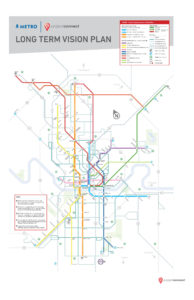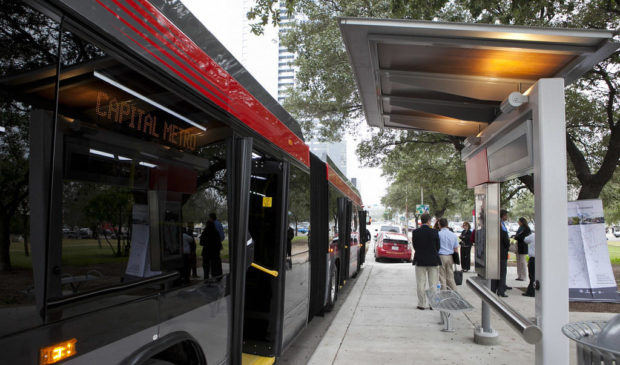It’s not just light rail. Capital Metro wants to expand rapid bus service, too.
Wednesday, October 16, 2019 by
Samuel King Austin’s regional transit agency, Capital Metro, is taking feedback from the public on a plan to add up to five new rapid bus lines.
It comes as ridership on the existing rapid bus lines, known as MetroRapid, has been rising. In September, Capital Metro saw a 10.1 percent increase in passengers over the same month in 2018. Ridership was up 14 percent for the 2018-19 fiscal year.
“The thing that makes that service great is it’s more frequent, it has priority lanes like downtown and even signal prioritization to help it go faster than the local bus service,” says Jackie Nirenberg, Capital Metro’s community engagement manager.
MetroRapid service started in January 2014 with the 801 line, which runs from Southpark Meadows to Tech Ridge. The 803 line came along in August 2014, running from Westgate Mall to the Domain.
Ridership on the existing lines has increased by more than 37,000 riders over the past year. Crowding has become an issue during some parts of the day.
“I was on the 801 the other day, and it was standing room only. Which is great! It means you have more people riding it,” said college student Grace Jones. “But it was also standing room only for the entire trip.”
Capital Metro says it has been adjusting spacing between buses and capacity on the routes to address overcrowding, including adding buses as needed to meet demand. Capital Metro long-range planner Jacob Calhoun says his team is taking what they’ve learned from the current lines as they contemplate the expansion.
“One of the things it definitely means is we have to find ways to improve that service even more,” Calhoun says. “So that means do we need to look at how we move it? Is there some way to get better signals to allow us to move the service faster? Can we get people on and off the service faster?”

A map of Capital Metro’s Project Connect, a long-term proposal for building out Austin’s transit network.
Capital Metro is looking at adding up to five new MetroRapid lines:
- Cherry Line from ACC Highland to Tech Ridge
- Navy Line from Berkman to McKinney Falls
- Pink Line along Seventh Street from Shady Lane to Red Bud and Exposition
- Lime Line along MLK from Springdale to West Austin
- Purple Line from downtown and along Manor Road to the expo center
Another line, the Yellow Line, is basically a rebranding of the existing MetroRapid 803 line which runs along the Burnet/South Lamar Corridor.
The new routes would complement the two major new transit lines that are proposed under Project Connect: the Orange Line, which would run in the Guadalupe/Lamar and South Congress corridors, and the Blue Line, which would run from near the UT campus through downtown and out to the airport. Those lines would have dedicated transit lanes, and be either light rail trains or bus rapid transit.
“We’re adding layers of access to the system to create one big seamless system that ideally people can use easier than driving a car,” Nirenberg said. “Once that happens, people say, Oh, I get it now.”
But some who attended a recent open house on the proposal wondered if that would happen since the proposed new MetroRapid lines would not have dedicated lanes along their entire routes. That means they could be subject to some of the same rush hour delays that impact the current lines.
“That’s probably the big one: The bus still gets caught up in traffic and it still stops,” said Matthew Novacek, who lives in North Central Austin. “So I was kind of hoping to see more improvement in that area, to kind of improve these lines.”
Capital Metro is hoping to fund the transit expansion with both local money and federal grants. Compared to the Orange and Blue lines, the proposed MetroRapid service would take less time to get going, since there are fewer startup costs and obstacles. The original MetroRapid project cost $39 million. The costs of light rail projects could be in the billions.
“The MetroRapid lines are relatively easy to implement, working with the city to get the priority treatments; we’re talking about maybe two to three years,” Nirenberg said. “It’s definitely the low-hanging fruit.”
Capital Metro is collecting more feedback over the next few months as it continues to shape its proposals. The agency’s board and Austin City Council will meet Oct. 30 to discuss Project Connect, and start narrowing down choices to present to voters in a likely November 2020 ballot referendum.
The last transit referendum in 2014 was defeated by a 14-point margin.
This story was produced as part of the Austin Monitor’s reporting partnership with KUT. Photo by Spencer Selvidge/KUT.
The Austin Monitor’s work is made possible by donations from the community. Though our reporting covers donors from time to time, we are careful to keep business and editorial efforts separate while maintaining transparency. A complete list of donors is available here, and our code of ethics is explained here.
You're a community leader
And we’re honored you look to us for serious, in-depth news. You know a strong community needs local and dedicated watchdog reporting. We’re here for you and that won’t change. Now will you take the powerful next step and support our nonprofit news organization?




